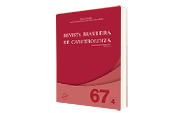Correlação entre Trihalometanos e o Desenvolvimento do Câncer de Bexiga
DOI:
https://doi.org/10.32635/2176-9745.RBC.2021v67n4.1588Palavras-chave:
Trihalometanos, Subprodutos da Desinfecção, Neoplasias da Bexiga UrináriaResumo
Introdução: Os trihalometanos (THM) constituem um grupo de subprodutos gerados pela desinfecção da água por meio da cloração. Desde a primeira vez em que foram reportados, em 1974, são alvos de estudos que buscam estabelecer uma relação positiva entre a exposição dos humanos a esses compostos e o desenvolvimento de câncer. Objetivo: Revisão da literatura cientifica disponível sobre a presença de THM na água e sua relação com o desenvolvimento do câncer de bexiga. Método: Levantamento bibliográfico da revisão feito nas bases de dados ScienceDirect e PubMeb. Os descritores utilizados foram ‘‘trihalomethane’’, ‘‘disinfection by-products’’ e ‘‘bladder cancer’’ dos Descritores em Ciências da Saúde (DeCS) da Biblioteca Virtual em Saúde. Os artigos selecionados foram publicados nos últimos cinco anos. Resultados: A amostra final desta revisão foi constituída por 31 artigos, sendo a maioria deles publicados em jornais e revistas sobre meio ambiente. Analisaram-se estudos descritivos, metanálises e outros estudos individuais com delineamento experimental, encontrando uma associação positiva, mas controversa, entre os THM e o câncer, associada a diferentes mecanismos. A relação mais consistente tem sido entre a exposição crônica e o câncer de bexiga. Conclusão: Os estudos reconhecem que existem riscos significativos a saúde relacionados aos THM, no entanto, evidencias que esclareçam os mecanismos de ação e o papel que outros fatores de risco possuem, juntamente com os THM, ainda permanecem incertas.
Downloads
Downloads
Publicado
Como Citar
Edição
Seção
Licença
Os direitos morais e intelectuais dos artigos pertencem aos respectivos autores, que concedem à RBC o direito de publicação.

Este trabalho está licenciado sob uma licença Creative Commons Attribution 4.0 International License.









